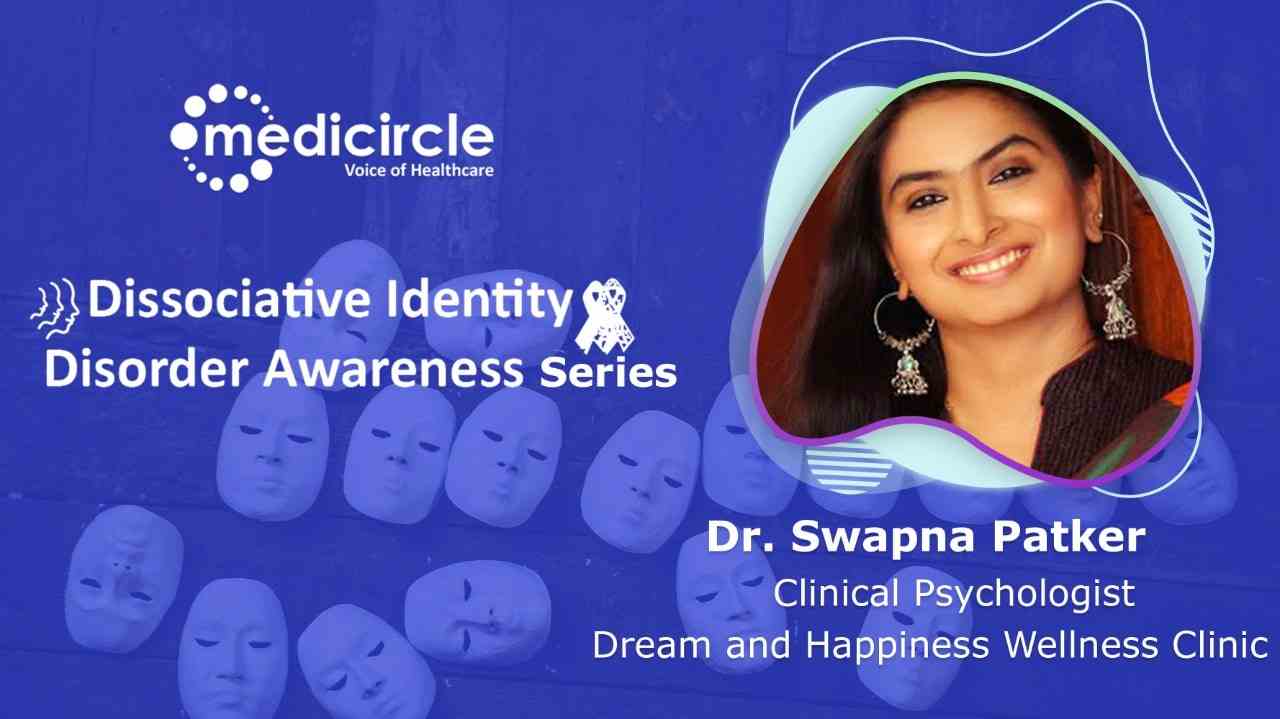Dissociative Identity Disorder was formerly called Multiple Personality Disorder. It often goes unnoticed among the general population. Those who suffer from this disorder lead terrifying and disturb life. Dissociative Identity Disorder Day, which is observed each year in the month of March aims to spread awareness of this disorder's existence and create understanding and compassion towards the people who are going through it. At Medicircle, we are conducting an exclusive series on the occasion of DID so that the people are able to understand what the disorder is directly from the experts.
Dr. Swapna Patker is a Clinical Psychologist consulting with Lilavati Hospital and has her own clinic, Dream and Happiness Wellness Clinic in Santa Cruz, Mumbai. 15 years in the field she has dealt with various mental health issues. She not just treats the patients but conducts a membership program in order to stay away from mental health hazards.
Identifying a DID patient is very difficult
Dr. Swapna informs, “DID has been seen in movies and books, people generally don't meet people with such kind of disorder. And it's very difficult for people to even assume or think about a disorder like this because they have not seen it actually. We can see depression, anxiety patients all around but finding a patient with DID seems very rare and unreal to people. So, identifying it becomes a very difficult deal for everyone. If a DID patient is moving around you, it could be very difficult for the person to assign to a fact that there is something wrong with this patient. So, slowly and steadily if you are very closely associated with a patient like that, then you will be figuring out that there is something wrong. It is very difficult to live with DID.”
DID patients behave differently at different times
Dr. Swapna suggests, “The major symptom that we can identify is that a person would behave very differently at different times. The person starts becoming unpredictable. There is a systematic response that is given by each one of us in every situation. But we cannot predict what reactions will be there of patients suffering from DID. Because on a certain topic, a patient might react in a manner, and on the other day, the patient might behave in an absolutely absurd and opposite manner. It becomes difficult for people to understand why this patient is changing stands, behaving differently, or talking exactly opposite of what he/she had spoken yesterday.”
DID patients are unpredictable
Dr. Swapna stresses, “Unpredictable is the word, you just cannot predict how they will react, because they have their different personality acting at different times. Unfortunately, even they do not realize that this is happening with them, the person surrounding them will assume that either the patient is a liar, or the patient is an actor, or the patient is a manipulator. The responses from people are very bad to such kind of a disease, the patient’s suffering increases because the patient just doesn't realize why I am getting this kind of responses from people.”
Traumatic history is the key feature
Dr. Swapna explains, “Researches and the experiences have shown that the causes of DID are based in your childhood or the early ages of your life. History of trauma is a key feature of DID. About 90 to 95% of DID cases involve some history of abuse in earlier stages of life, mostly childhood. This trauma often involves severe emotional, physical, and sexual abuse. It can also be linked to some kind of accident, like if you've gone through a certain natural disaster. Even the loss of your parents, your loved ones could also be a reason. There are cases of DID seen in patients with complete isolation due to some illnesses like AIDS, persons staying away from that patient can also be a developing factor for DID.”
DID alters the person
Dr. Swapna speaks, “There is no such specific age which says that at this age DID has developed into you, but the roots are definitely in some of the other kind of trauma. So, after the trauma, we cannot predict in how much time DID will be developed in a person.”
Dr. Swapna talks, “Slowly and steadily it keeps altering the person. Generally, you can observe it very late, because it takes time to sink into you. For example, if trauma has happened at the age of 10, it might take 10 years to sink into you and develop the DID. It takes the longest time to analyze and reach a diagnosis that the patient is suffering from DID. By this time, people have judged the patient so badly that it becomes very difficult to retract and repair what they have done.”
Valuable advice to the parents
Dr. Swapna says, “If parents find any new set of behavior in their child, they just go to google and put their symptoms and check what it is. But that is the very wrong thing. Because only a professional will be able to tell you or guide you what it exactly is.”
Dr. Swapna elaborates. “If there is any unpredictability seen in the behavior of a child. For example, if a child is very subtle, mild, and calm on one day, and very aggressive the other day. This is one pattern that can be followed. Or, if a child likes to study but certainly does not like to study on other days, it needs to be watched whether this unpredictability is going to extremes or not. If it does fluctuate too much, then this is a sign, you need to meet a doctor. There will be different kinds of changing personality patterns. They just stop associating with certain things or certain situations of the past. They will not agree to certain things that they have spoken about. So, all the memories also dissociate with their personality. Parents have to watch their child for all these symptoms.”
(Edited by - Renu Gupta)

 “Traumatic history is a key feature of DID. About 90 to 95% of DID cases involve some history of trauma in earlier stages of life, mostly childhood. This trauma often involves severe emotional, physical and sexual abuses,†Dr. Swapna Patker, Clinical Psychologist
“Traumatic history is a key feature of DID. About 90 to 95% of DID cases involve some history of trauma in earlier stages of life, mostly childhood. This trauma often involves severe emotional, physical and sexual abuses,†Dr. Swapna Patker, Clinical Psychologist





.jpeg)
.jpeg)
.jpeg)



.jpeg)
.jpeg)
.jpeg)






.jpeg)

.jpg)




.jpg)




